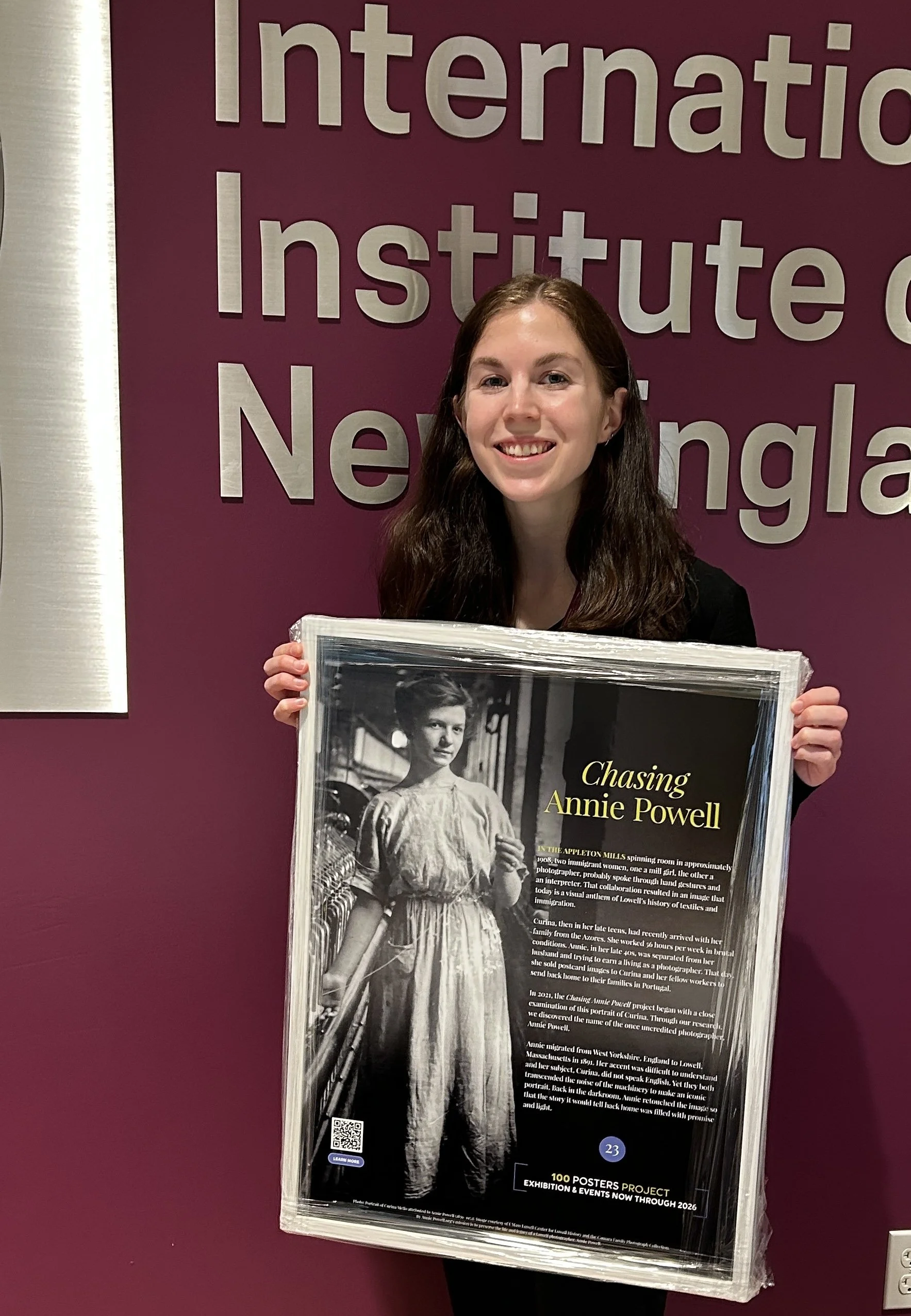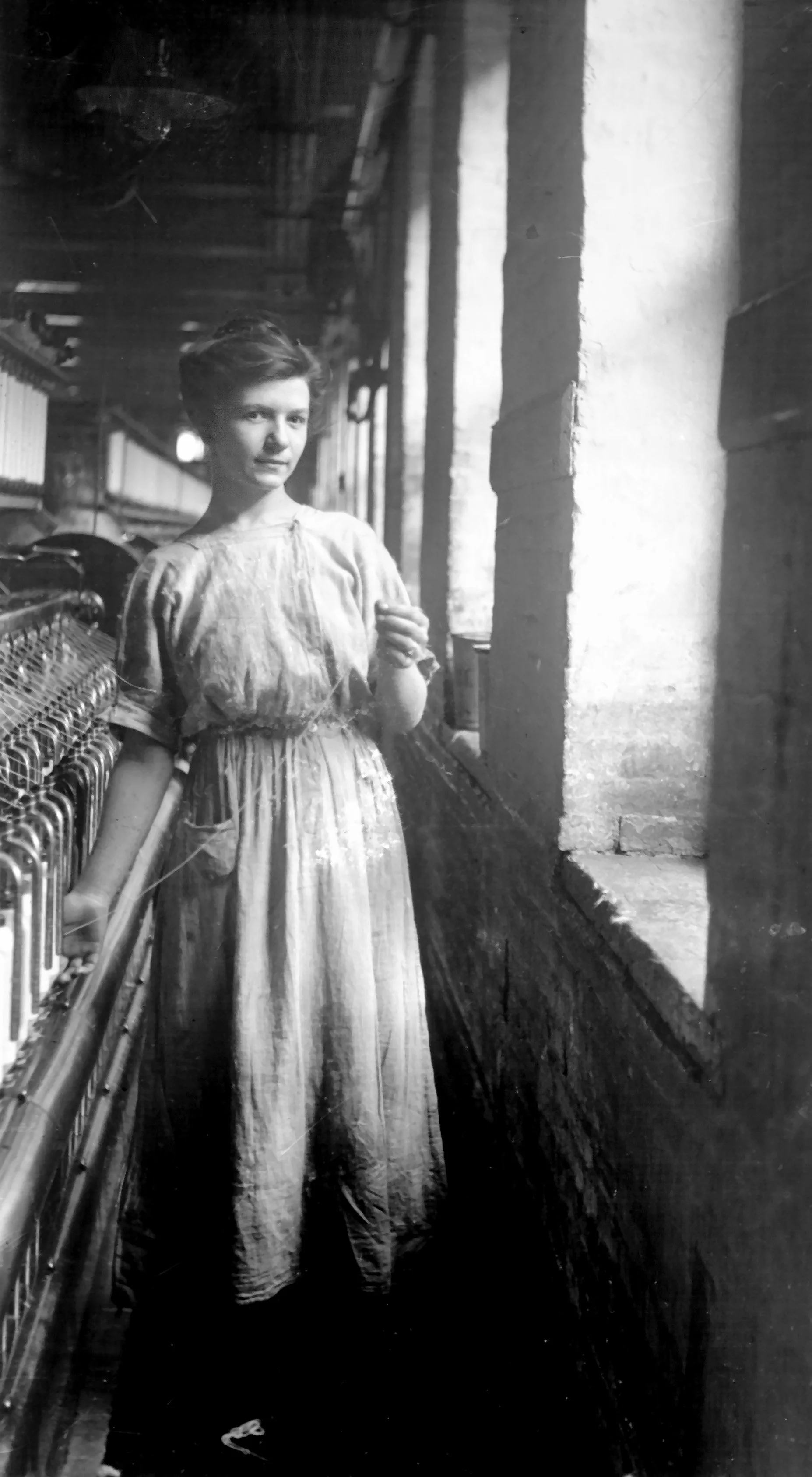A circa 1919 photograph of Dela Braga, a second-generation Portuguese immigrant. Similar to Curina’s portrait taken a decade earlier at Appleton Mills, Dela’s relaxed pose belies the harsh work environment. This is an actual photo postcard that features Annie’s handwritten instructions to deliver it to 114 Stromquist Ave. Courtesy Lowell Historical Society
To celebrate Annie’s work in and around Lowell, we’ve launched the 100 Posters Project. We are currently in the process of distributing 100 posters to local businesses, nonprofits and government agencies that now occupy buildings or have addresses on streets that Annie photographed one-hundred years ago. Our goal is to show how Lowell neighborhoods appeared in Annie’s time in relation to Lowell today.
Poster 23 of 100
Over a century ago two immigrant women created a visual anthem of Lowell history
Sarah Benson, program administrator for International Institute of New England, at 101 Jackson Street, hosting Poster #23. For over a century, the organization has served the needs of area immigrants.
Two oral histories, client data, compositional style, and technical comparisons point to Annie Powell as the photographer of this Progressive Era image of the mill worker Curina Mello. Courtesy UMass Lowell Center for Lowell History Camara Collection
In and around 1909 at the Appleton Mills spinning room, two immigrant women, one a mill girl, the other a photographer, likely communicated through wordless hand gestures. Neither spoke the other’s language, but the resulting portrait is a testament to their collaboration: it is both a portrait of immigration and the history of textiles; a visual anthem of Lowell’s story of immigration and commerce.
At the time of the portrait, the model, Curina Mello, was in her late teens. She worked a 56-hour week in brutal, dangerous conditions. Annie Powell, then in her late 40s and separated from her husband, was scraping out a living as a photographer. That day, she moved among the Portuguese-American workers at the mill to sell postcard portraits. After printing the images in her darkroom, she would deliver them to the to her client personally. Many would be mailed back to families in Portugal with news of family and America.
The finest image that day was of Curina, who immigrated with her parents and siblings about a year before. Both women transcended the din of heavy machinery to create this alluring and iconic portrait of Lowell in the early 20th century. While developing the image, Annie lightly retouched the negative by hand, adding highlights and shadows so that the tale it would tell back home was filled with promise and light.
Not long after she posed for the portrait, Curina married loom fixer Francisco Paul Cortez, also Azorian, and left mill work entirely. Cortez also left Appleton, and later published a Portuguese-language newspaper. Curina lived a long life, and died at age eighty-eight in 1980. Annie, ever industrious, continued to make images, working on various municipal projects until a few years before her death in 1952.
The traveling art exhibition Chasing Annie Powell 100 Posters Project began in 2021 with my close scrutiny of Curina’s portrait. Through extensive research, I uncovered the identity of Annie Powell, an under-appreciated photographer who immigrated from West Yorkshire, England to Lowell in 1891.
The photograph is one of about one-hundred portraits Annie made of Appleton Mills workers and her Portuguese-American neighbors in the early part of the 20th century. Most of these, like the Curina portrait, are part of the UMass Lowell Center for Lowell History Camara Collection. Significantly, in Annie’s final effects one Portuguese-American subject and her family are seen throughout the approximately 15-year span of the Camara Collection. Two oral histories trace the provenance from storage in Annie’s former Lowell Highlands darkroom through to donation to the Camara Collection in 1989. When I examined her final effects and work in other institutional archives, I learned that Portuguese-Americans made up a large portion of her regular client base. An example is a circa 1919 Appleton Mills postcard portrait of Dela Braga (see below), owned by the Lowell Historical Society.
Permission to photograph inside the factory was restricted but Annie was given broad access. It’s possible a compatriot from the United Kingdom, mill treasurer A.G. Cumnock, helped her gain entry. Cumnock was also first president of the Lowell Textile School, a place with many U.K. accents where Annie and husband John Powell seemed to have been the sole documentary and portrait photographers. Annie’s particular technique of retouching glass plate negatives as well as her penmanship can be seen on Appleton Mills management and staff portraits taken between 1916 and 1919. These images are now in archives of the Kheel Center at Cornell University.




